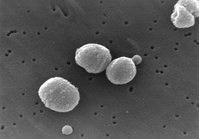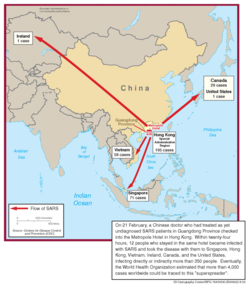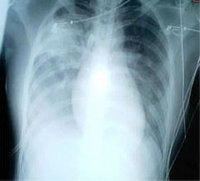The early diagnosis of suspected severe acute respiratory syndrome (SARS) is essential to allow for early isolation and treatment. The case definition developed by the World Health Organization (WHO) defines a suspect case as a patient with high fever, cough or breathing difficulty, and direct exposure or travel through a SARS-affected region within 10 days before symptom onset. A probable case meets the criteria for a suspect case and has additional chest radiographic evidence of infiltrates or laboratory results positive for SARS coronavirus. The use of these criteria alone, however, may result in underdiagnosis. Leung and associates developed a clinical prediction rule for diagnosis to identify SARS in the emergency department during an outbreak.
Clinical and laboratory data from patients presenting to the SARS triage clinics of two large hospitals in Hong Kong were abstracted for analysis by the authors. Using cohorts of patients treated during SARS outbreaks with a SARS diagnosis confirmed by laboratory testing, a two-step prediction rule was derived. Step one identified the subgroup of patients likely to have SARS and need further evaluation, and step two involved analyzing this high-risk population for radiologic and laboratory characteristics.
In step one, age in years and contact history were associated with a SARS diagnosis, as was the presence of three symptoms: fever, myalgia, and malaise. The absence of sputum production, abdominal pain, sore throat, and rhinorrhea also were independently associated with a SARS diagnosis.
In step two, four laboratory or radiographic findings were associated with a SARS diagnosis, including chest radiograph, lymphocyte count, neutrophil count, and platelet count. After inclusion of step two investigations, several of the historical and physical finding factors no longer achieved statistical significance.
The scoring system used to quantify the association of certain risk factors with SARS are listed in the accompanying table. The higher the score beyond 8, the higher the risk of SARS, with a risk score of 19 or greater representing the highest-risk group. Using this prediction rule achieved a sensitivity of 0.90 and a specificity of 0.62. An internal validation exercise showed good results.
The authors conclude that this prediction rule for SARS risk would allow rapid triage of patients. Patients designated as low risk could be sent home with daily follow-up for the four- to five-day incubation period that precedes the severe clinical syndrome. Patients whose risk score exceeds 8 should be admitted with room allocation guided by the total risk score. Prospective validation of this clinical prediction rule is needed if SARS returns.
RICHARD SADOVSKY, M.D.
Leung GM, et al. A clinical prediction rule for diagnosing severe acute respiratory syndrome in the emergency department. Ann Intern Med 2004;141:333-42.
EDITOR'S NOTE: Epidemiologic studies of severe acute respiratory syndrome coronavirus hint that a repeat epidemic from infected animals or laboratory-stored specimens is possible. In an accompanying editorial, Jernigan and associates (1) note the need for better diagnostic techniques in the first few days of illness. The clinical prediction rule described above may be useful, but external validation is essential because of epidemiologic variables that have been occurring among affected groups in different settings and geographic regions. It also is unclear that a prediction rule derived during an epidemic will be helpful in sporadic cases noted between outbreaks.
REFERENCE
(1.) Jernigan JA, Helfand RF, Parashar UD. Accurate clinical prediction of severe acute respiratory syndrome: are we there yet? Ann Intern Med 2004;141:396-8.
COPYRIGHT 2005 American Academy of Family Physicians
COPYRIGHT 2005 Gale Group




